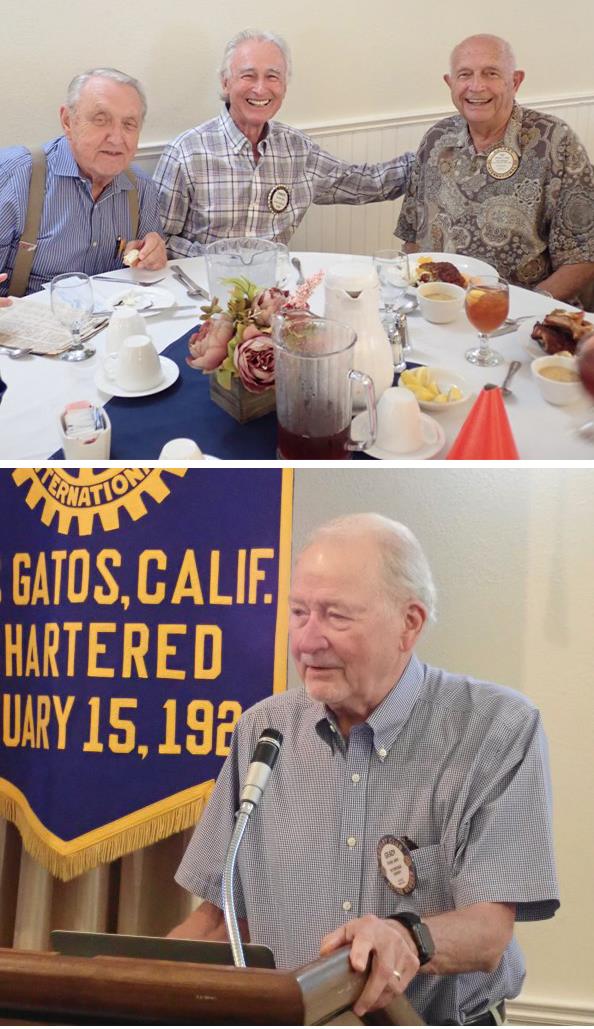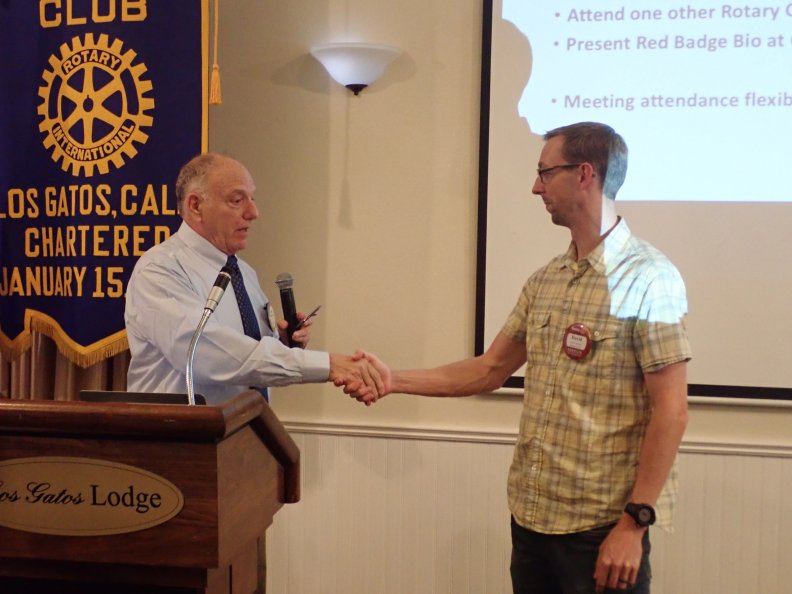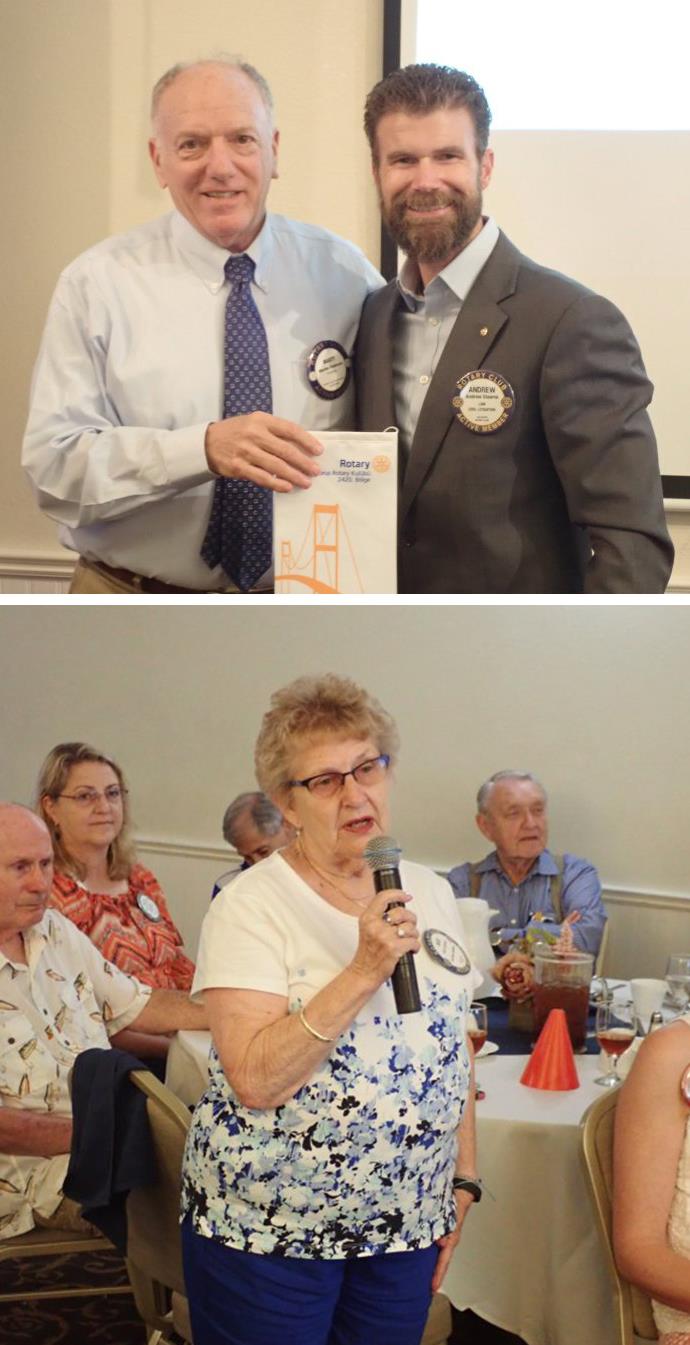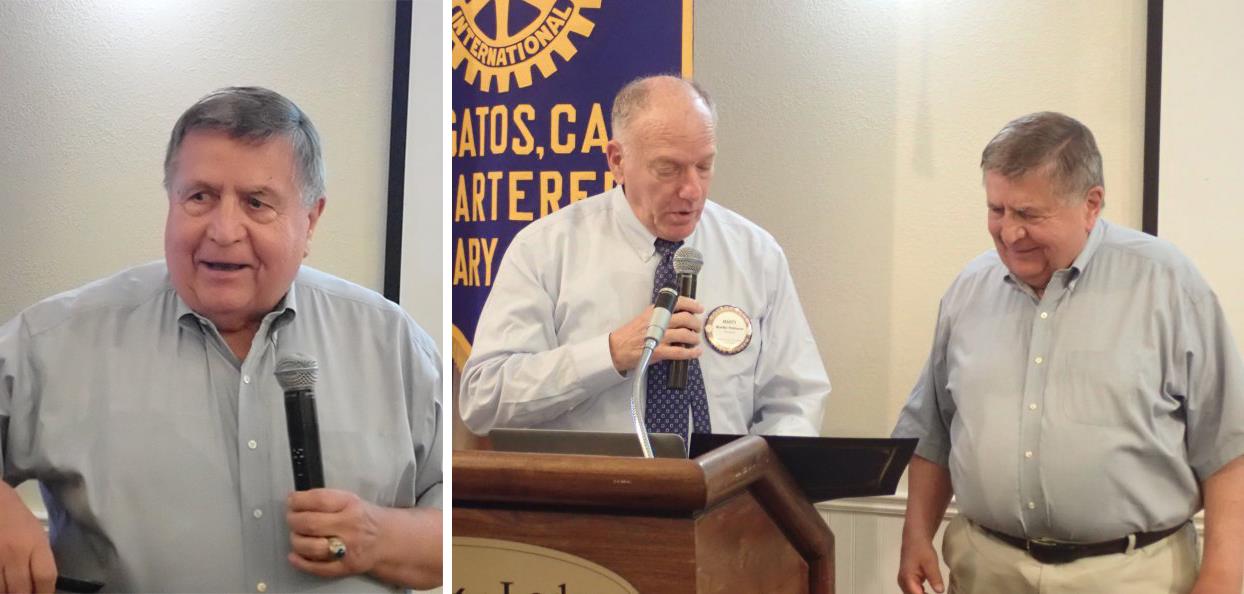 President Marty Fishman brought the club to order, and Doug Brent led the pledge and introductions of visiting Rotarians and guests.
President Marty Fishman brought the club to order, and Doug Brent led the pledge and introductions of visiting Rotarians and guests.We had a rare appearance by club member Charlie Goss – seen setting between LeRoy Neider and Ed Stahl.
Grady Jeeter, noting the dramatic and horrific attacks over the last days inspired us with a reading of the thoughtful Desiderata by Max Ehrmann.
Happy August Birthday to Rotarians! Six birthdays and many anniversaries were recognized on Tuesday. And, the entire club enjoyed Marty’s reflections on what a birthday means via a Seinfeld video and a YouTube video. Key advice: keep your teeth in your mouth when you’re blowing out the candles!
Service Activities and Events
Marty then reviewed a full slate of recent and upcoming service activities and club events. Note more details are available on our club home page, and President Marty will send out his usual email update with reminders and pointers as well.
Lisa Cheskin organized the quarterly Fisher House Palo Alto dinner last week. Volunteers participating in the event included Doug and Marjorie Brent, Kristen Bridges, Erika Buck and with Michelle Myers Nelson leading the charge.
Rotarians are invited to an event to clean up the creek at Campbell Park, August 24, 8:45-11AM.
Our club is supporting two events on 14 September. There will be a car show at the Palo Alto VA, and we are looking for volunteers to chaperon vets to the event. Contact Lisa Cheskin if interested, and we do still need volunteers there. The car show will take place from 10AM-2PM. The other event on that day is Rise Against Hunger at the church at 111 Church Street in Los Gatos. This is a great event for almost any age volunteer.
This year, our Rebuilding Together Silicon Valley service event will be on 19 October. Sign-ups will start soon. Contact Suzanne Boxer-Gassman or Doug Brent for information or questions.
It is not too early to start planning for the 2020 Crab Fest event, and our event Chair, Suzanne Boxer-Gassman, is holding a planning meeting at her home on 14 August, Her address is 137 E Porton Los Gatos, and we do still need additional leaders on this committee. Please contact Suzanne if you are interested.
On Tuesday 27 August, we are having the Los Gatos Rotary BBQ, with Andrew Stearns taking the lead on the cooking team yet again. Tickets are $45. Tickets are available through our club site online (click the event link) and Tony is selling tickets at upcoming meetings.
0n 17 August, there is a District conference on Membership. This will be held at the Hyatt House San Jose, and advance sign-up is required. Please visit the district web site to sign up
There will be a new Rotary club chartered with an event planned for this Friday. See district web site for more details.
The speaker at our club meeting next week is Nick Kuwada from the Santa Clara County office of the census. He will discuss the importance of the census, and how his team is working towards an accurate count.
Club Membership
 President Marty reminded us about the updated requirements for advancing from a Red Badge to a Blue Badge, and the reduced focus on meeting attendance as the metric for Rotary membership. He also covered the new membership categories: family and business. These new categories make it easier and more economical for family members and business colleagues to be Rotary members together.
President Marty reminded us about the updated requirements for advancing from a Red Badge to a Blue Badge, and the reduced focus on meeting attendance as the metric for Rotary membership. He also covered the new membership categories: family and business. These new categories make it easier and more economical for family members and business colleagues to be Rotary members together. And...President Marty announced a new Blue Badge club member: David Hubbard. Congratulations David on completing the requirements, and for sporting your new Blue Badge!
As part of President Marty’s initiative to provide Rotary education during our meetings, he showed a video of Rotary History - starting with the first meeting in Chicago on 23 February 1905, and recent events in international service and evolution of Rotary culture. Some notable points:
- The forerunner of the Rotary Foundation dates back to an endowment created in 1917. Service was established as a unifying theme for Rotary in the first few years of its inception.
- There is a long list of highly accomplished and famous rotarians. In the first U.N. charter conference, more than 50 delegates were Rotarians.
- The Polio Plus initiative started in the 1980s, and Rotary has donated more than $500 million dollars and significant volunteer time to reducing, and ultimately eliminating Polio everywhere in the world.
- Also in the 1980s, with the fall of the USSR, Rotary International was reunited with Eastern Bloc clubs, and, importantly, women were welcomed as Rotarians.
- What has been accomplished in the first 100 years of Rotary is not just history, but a legacy on which to build the next 100 years and beyond.

Andrew Howard made a donation to the club of $100 in recognition of his one month trip around the world, and told the story of going to a Turkish Rotary club that was full of German speakers - who simply switched to English when he arrived to make everything accessible to him. We are part of an international fellowship!
Avis La Grone made a donation of $100 to highlight the Rotary Vietnam project she led. Avis just returned from Vietnam four days before our meeting. She was joined on this trip by two students, one from east San jose and one from Castro Valley. As a team, they taught four two hour classes per day for five days at one facility, then another five days teaching English at another.

Today’s presentation was provided by Gaylord Green who was a pioneer in the U.S. program for GPS - Global Positioning System. Gaylord was a program manager for over a decade, and was in the USAF, and earned a graduate degree from Stanford in Aeronautics and Astronautics.
Clearly, the impact of GPS has been enormous - from simple mapping applications on a mobile phone, to military applications and now to industrial applications like construction and farming.
But, at the beginning, people had a hard time conceptualizing why determining a position was even important. Gaylord told us that people said: “I know where I am. Why do I need GPS to tell me my location?”
The mission of the GPS group was to be able to provide four crucial pieces of information virtually anywhere on the planet: latitude, longitude, altitude and time. The GPS system has delivered on this mission, and at accuracy levels that exceeded what many thought were possible, with positional accuracy of an inch or so, and time resolution of 10 nanoseconds.
Gaylord (with a couple of Rotarian assistants) provided a demonstration with string and a mock satellite showing how GPS position is determined. Since a location on the earth is defined by three points - x, y, and height,, if a point on earth has visibility to three satelite (four to get the time dimension as well), that point can be effectively located. The GPS system has 24 satellites, so most places on the earth have good visibility to well more than four satellites, but being in a tunnel or an urban canyon reduces this visibility, and gives us the strange GPS results we sometimes see in San Francisco or elsewhere.
So if it is just a matter of putting up some satellites, and measuring distances to the ground, what is so hard about GPS? This is just a geometry problem, right? Well, there are some practical challenges that make this a hard problem to solve with accuracy. These issues include:
- Accurate orbit estimation: The satellites circle the earth at about 12,000 miles away. The signals are faint on the ground, and the satellites themselves have some motion while in orbit. This requires constant ground control monitoring and management of the radio frequency spectrum to avoid interference.
- Synchronized timing across all of the satellites is essential to deliver an accurate position. Gaylord told a story about Edward Teller advising the GPS team that they had to account for special relativity effects in the clocks running on the earth vs. the ones in space.
- The earth is not perfectly round, and continents move. In the recent New Zealand earthquakes, land moved by many feet.
- Atmospheric, ionospheric and solar conditions can impact GPS performance.
Gaylord noted that the GPS program was essentially contemporaneous with the first personal computers, and benefited greatly from the accelerating semiconductor power. Some external events impacted the program significantly. President Reagan publicly committed the delivery of the GPS system after Russians shot down KLA 007. And, President Clinton ended the practice of degrading the quality of the civilian GPS signal.
We think of the primary uses of GPS to be location oriented, but it is also the world’s timing system. Cell phone towers, banking data centers, and power systems all use GPS for precise and coordinated timing.
Finally, GPS has spawned numerous national positioning systems from other countries and regions: Beidou for China. GLONAS for Russia, Galileo for the EU, and regional systems in Japan and India. civilian use;
Gaylord showed some pride about the reliability of the GPS satellites - which are now in their third generation. He had a significant, early insight that to manage a system which included 24 satellites, and the ground team to manage them - satellite lifetime and reliability would make the whole system simpler to manage, and that has proven to be a key aspect of reliable GPS service delivery.
Gaylord also offered that if we want to learn more, to view the documentary “The Lonely Halls Meeting” (trailer available here).

After a lively Q&A, President Marty closed the meeting.